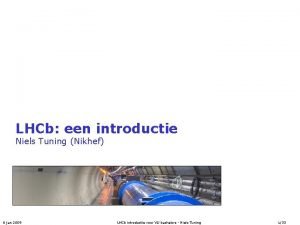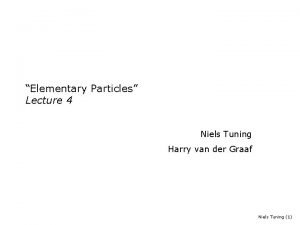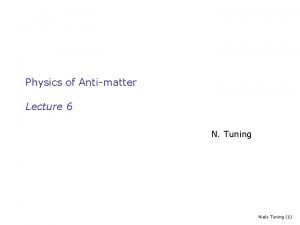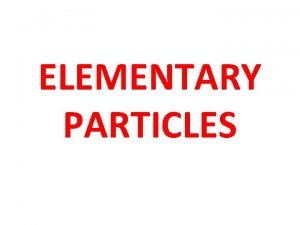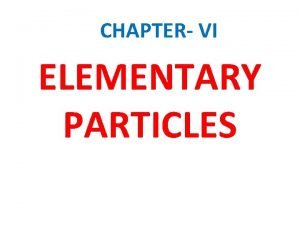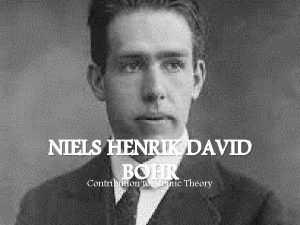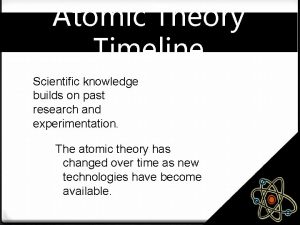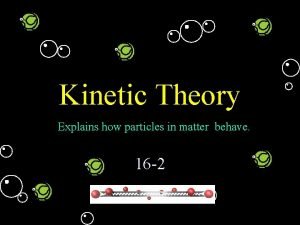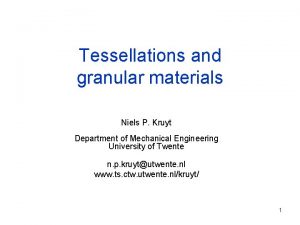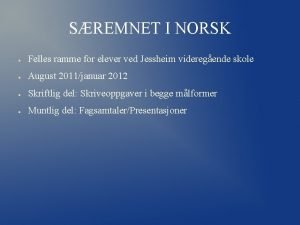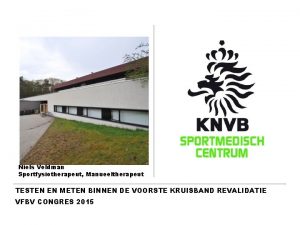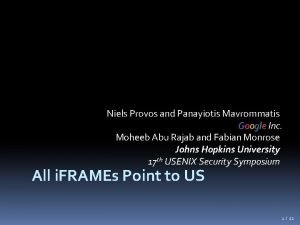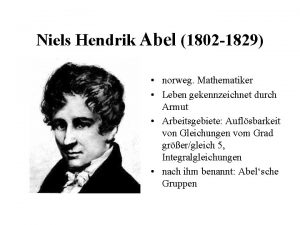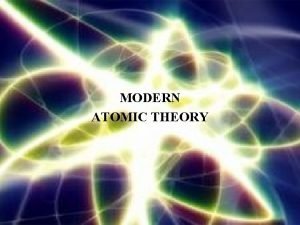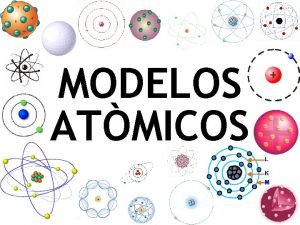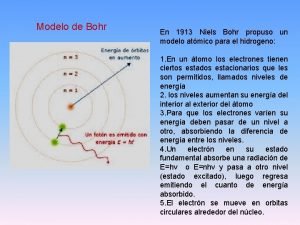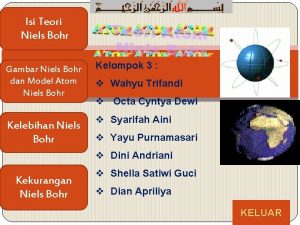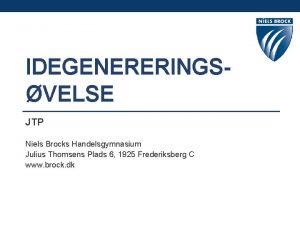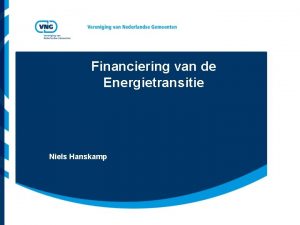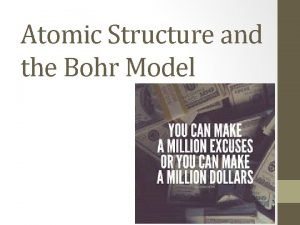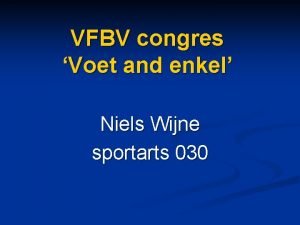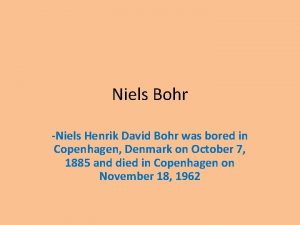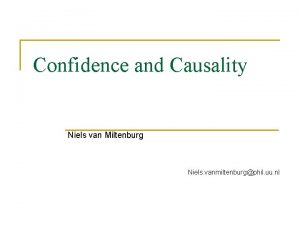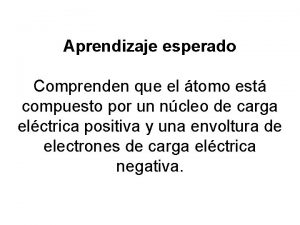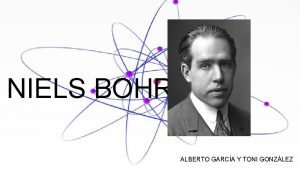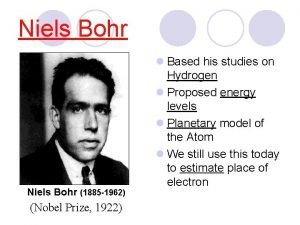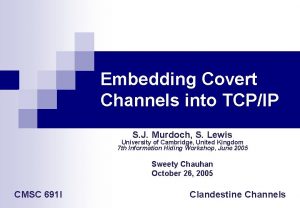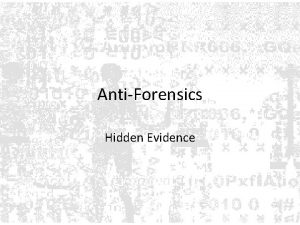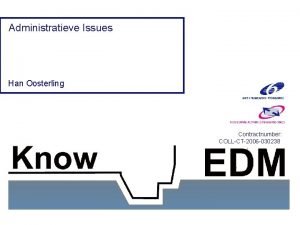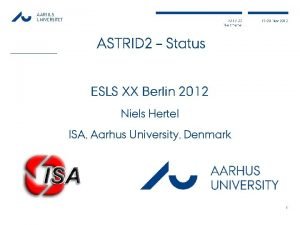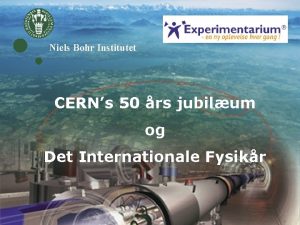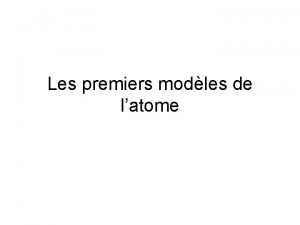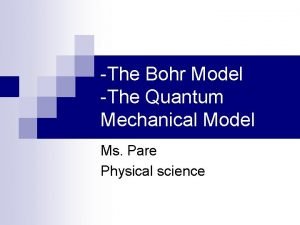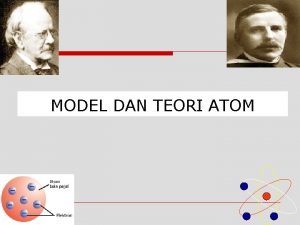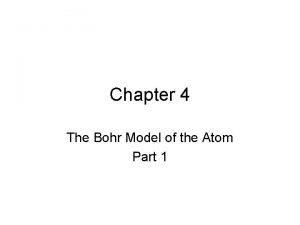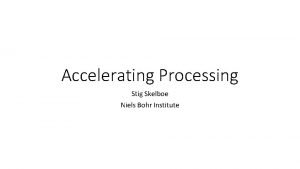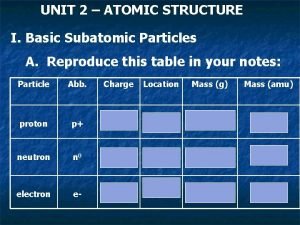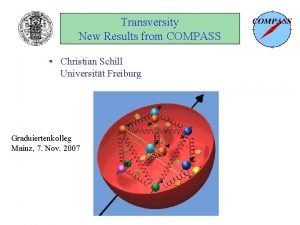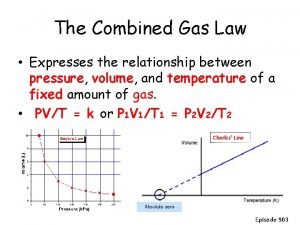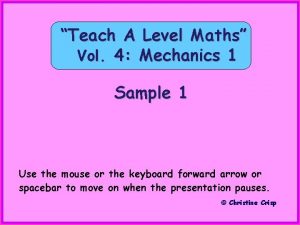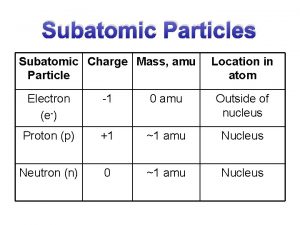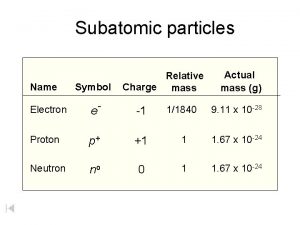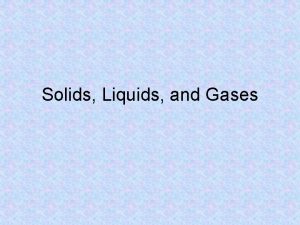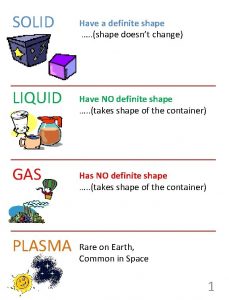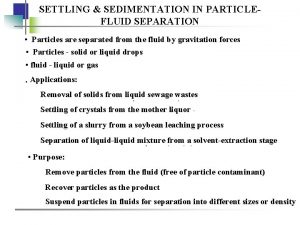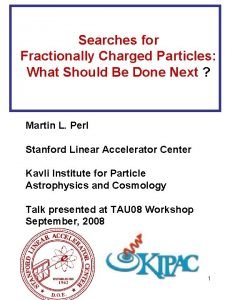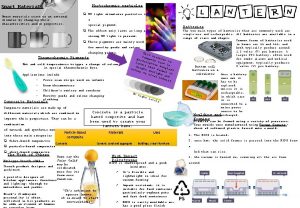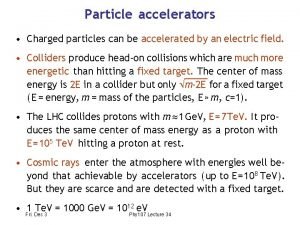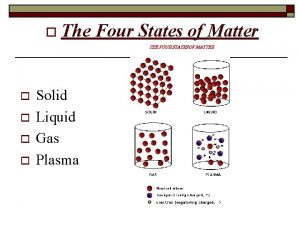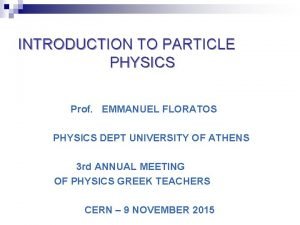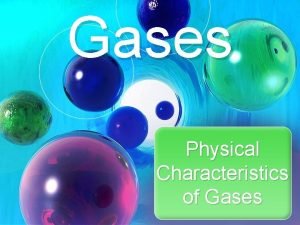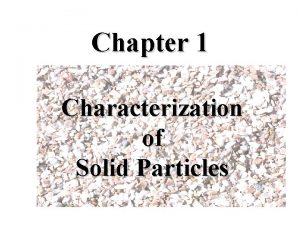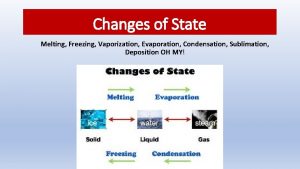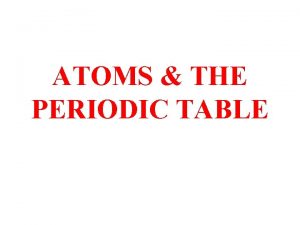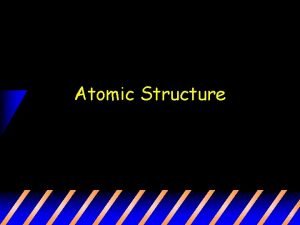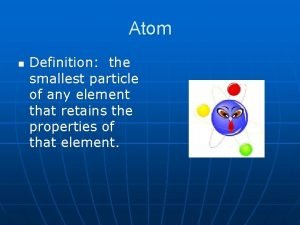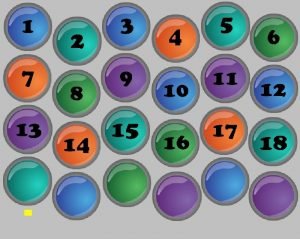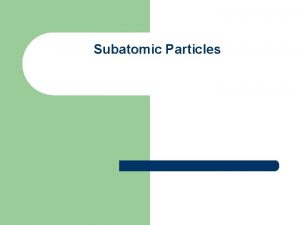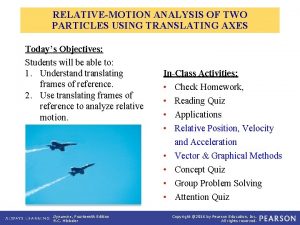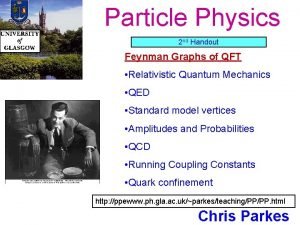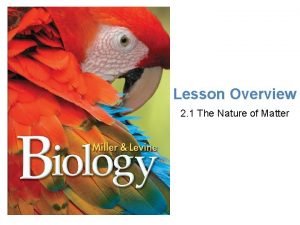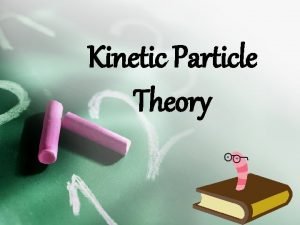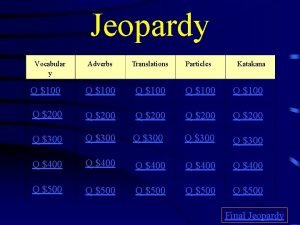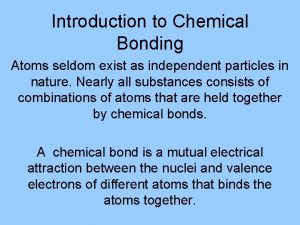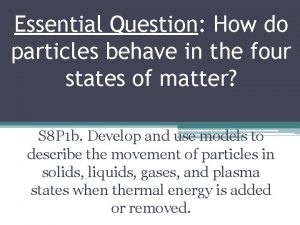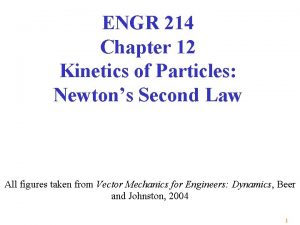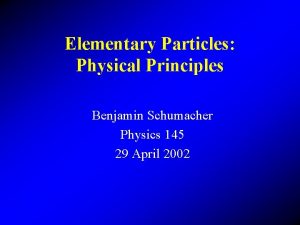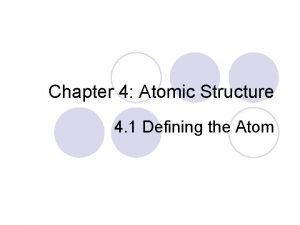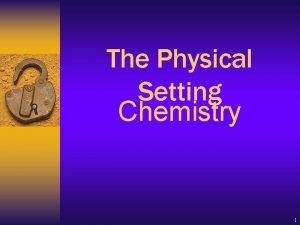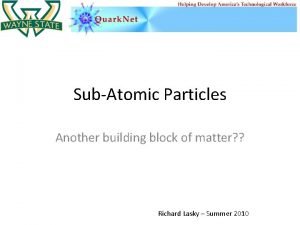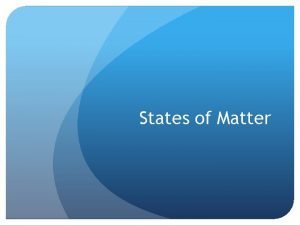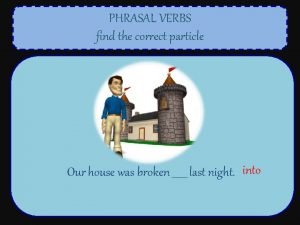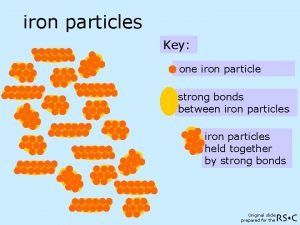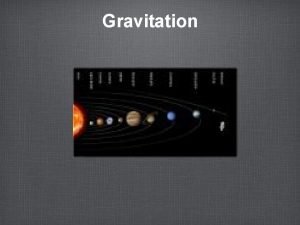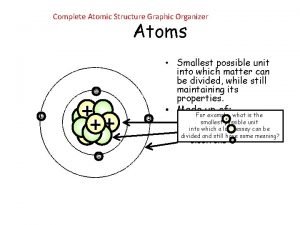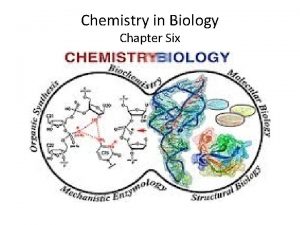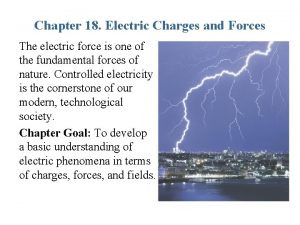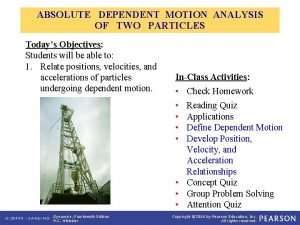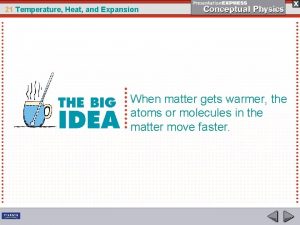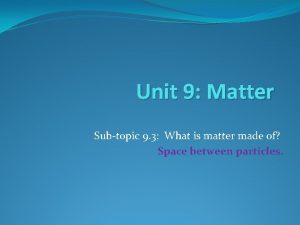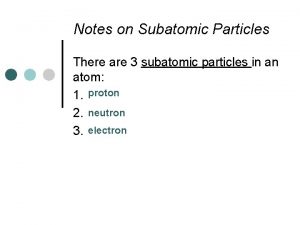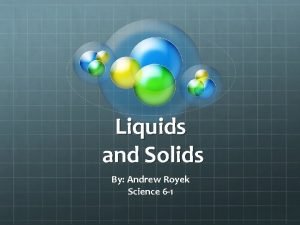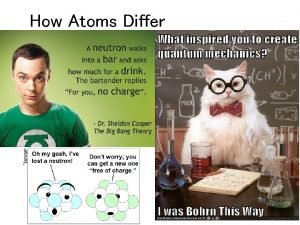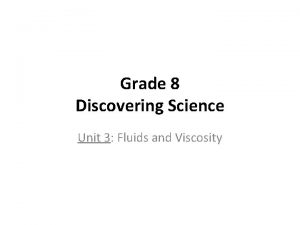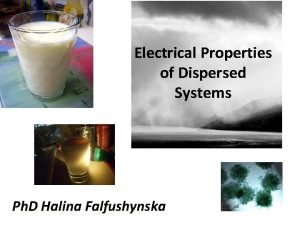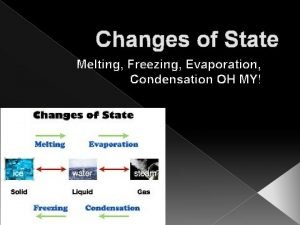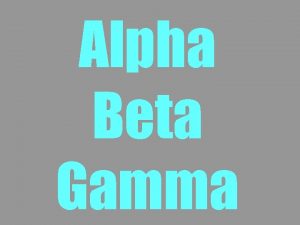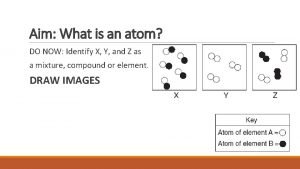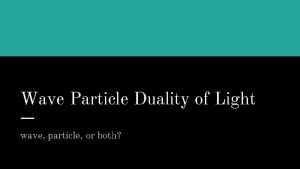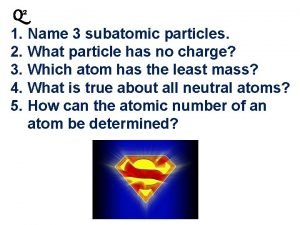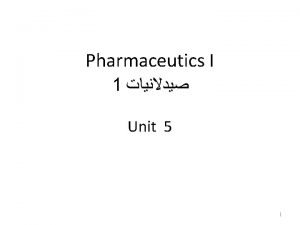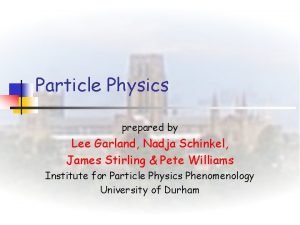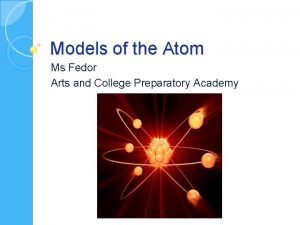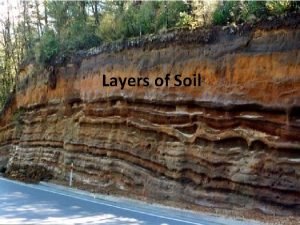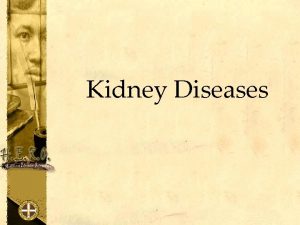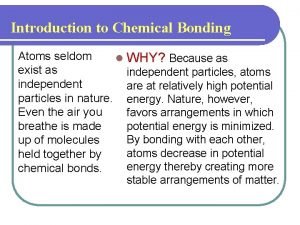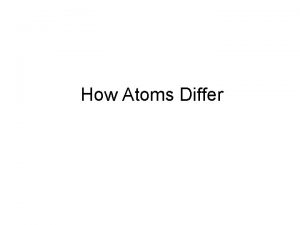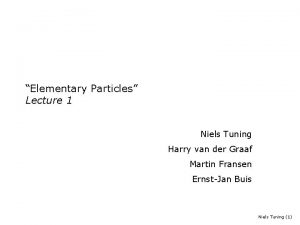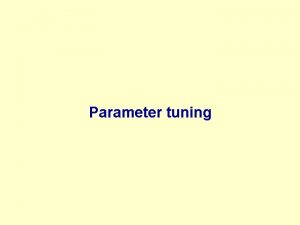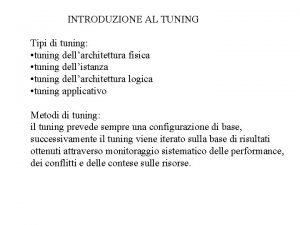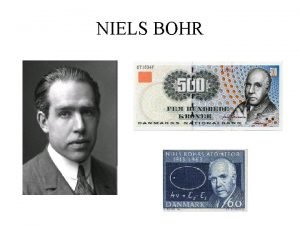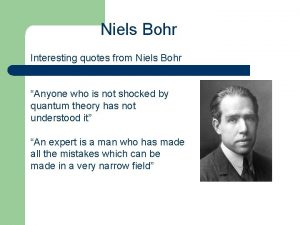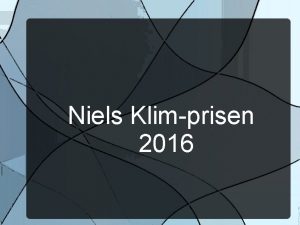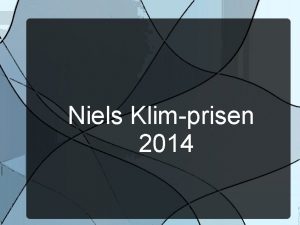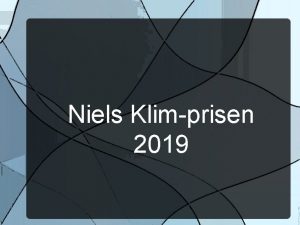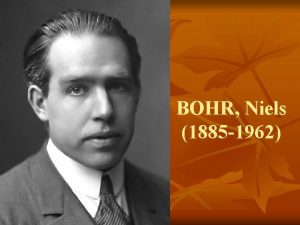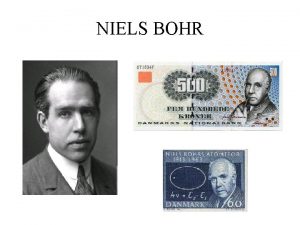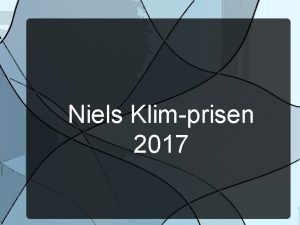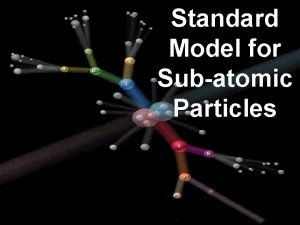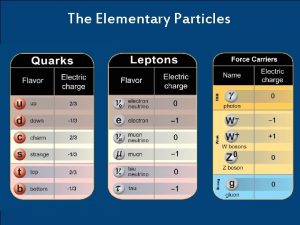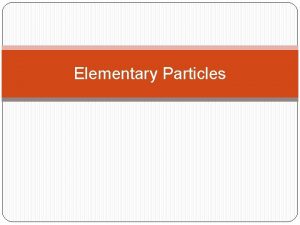Elementary Particles Theory Lecture 6 Niels Tuning 1




































































































































- Slides: 132

“Elementary Particles” Theory Lecture 6 Niels Tuning (1)

Thanks • Ik ben schatplichtig aan: – Dr. Ivo van Vulpen (Uv. A) – Prof. dr. ir. Bob van Eijk (UT) – Prof. dr. Marcel Merk (VU) Niels Tuning (2)

Plan Theory Quantum Mechanics Detection and sensor techn. Quantum Field Theory Forces Interactions with Matter Accelerators Bethe Bloch Photo effect Compton, pair p. Bremstrahlung Cherenkov Cyclotron X-ray Proton therapy Astrophysics Fundamental Physics Cosmics Grav Waves Neutrinos Special Relativity General Relativity Particles Light Scintillators PM Tipsy Medical Imag. Charged Particles Si Gaseous Pixel Gravity Experiments ATLAS Km 3 Net Virgo Lisa … Optics Laser Niels Tuning (3)

Plan Today Theory 2) Niels Quantum Mechanics Fundamental Physics 2) Niels Quantum Field Theory 6) Ernst-Jan Niels 7) + 10) Forces 5) + 8) Particles 1) Harry Accelerators Astrophysics 1) Niels Special Relativity 9) Ernst-Jan General Relativity Detection and sensor techn. 3) Harry Relativistic. I nteractions with Matter 4) Harry Light 11) +12) Martin Charged Particles 9) Ernst-Jan Gravity 6) + 9) Ernst-Jan Martin 13) + 14) Excursions Experiments 9) Ernst-Jan Optics Niels Tuning (4)

Schedule 1) 11 Feb: Accelerators (Harry vd Graaf) + Special relativity (Niels Tuning) 2) 18 Feb: Quantum Mechanics (Niels Tuning) 3) 25 Feb: Interactions with Matter (Harry vd Graaf) 4) 3 Mar : Light detection (Harry vd Graaf( 5) 10 Mar: Particles and cosmics (Niels Tuning) 6) 17 Mar: Forces (Niels Tuning) 7) 24 Mar: Astrophysics and Dark Matter (Ernst-Jan Buis) break 1) 21 Apr: e+e- and ep scattering (Niels Tuning) 2) 28 Apr: Gravitational Waves (Ernst-Jan Buis) 3) 12 May: Higgs and big picture (Niels Tuning) 4) 19 May: Charged particle detection (Martin Franse) 5) 26 May: Applications: experiments and medical (Martin Franse) 6) 2 Jun: Nikhef excursie 7) 8 Jun: CERN excursie CANCELLED We try to organize special lecture(s) Tue 9 June Niels Tuning (5)

Plan 1900 -1940 1945 -1965 -1975 1) Intro: Standard Model & Relativity 11 Feb 2) Basis 18 Feb 1) Atom model, strong and weak force 2) Scattering theory 3) Hadrons 1) Isospin, strangeness 2) Quark model, GIM 4) Standard Model 1) QED 2) Parity, neutrinos, weak inteaction 3) QCD 10 Mar 17 Mar 1975 -2000 5) e+e- and DIS 21 Apr 2000 -2015 6) Higgs and CKM 12 May Niels Tuning (6)

Homework

Homework Lecture 5 Niels Tuning (8)

Homework Lecture 5 f) g) Niels Tuning (9)

Homework Lecture 5 3. 3 3. 7 Niels Tuning (10)

Homework Lecture 5 Niels Tuning (11)

Homework Lecture 5 3 Niels Tuning (12)

Outline for today: 1) Higgs mechanism 2) Higgs discovery at ATLAS 3) CKM-mechanism 4) CP violations at LHCb Niels Tuning (13)

Summary Lects. 1 -5

Lecture 1: Relativity • Theory of relativity – Lorentz transformations (“boost”) – Calculate energy in collissions • 4 -vector calculus • High energies needed to make (new) particles Niels Tuning (15)

Lecture 1: 4 -vector examples • 4 -vectors: – Space-time x – Energie-momentum p – 4 -potential A – Derivative ∂ – Covariant derivative D – Gamma matrices • Tensors – Metric g – Electromagnetic tensor F Niels Tuning (16)

Lecture 2: Quantum Mechanics & Scattering • Schrödinger equation – Time-dependence of wave function • Klein-Gordon equation – Relativistic equation of motion of scalar particles Ø Dirac equation – Relativistically correct, and linear – Equation of motion for spin-1/2 particles – Described by 4 -component spinors – Prediction of anti-matter Niels Tuning (17)

Lecture 2: Quantum Mechanics & Scattering • Scattering Theory – (Relative) probability for certain process to happen – Cross section Scattering amplitude in Quantum Field Theory Classic • Fermi’s Golden Rule – Decay: “decay width” Γ a→b+c – Scattering: “cross section” σ a+b→c+d Niels Tuning (18)

Lecture 3: Quarkmodel & Isospin • “Partice Zoo” not elegant • Hadrons consist of quarks Ø Observed symmetries – Same mass of hadrons: isospin – Slow decay of K, Λ: strangeness – Fermi-Dirac statistics Δ++, Ω: color • Combining/decaying particles with (iso)spin – Clebsch-Gordan coefficients Niels Tuning (19)

Lecture 4: Gauge symmetry and Interactions • Arbitrary “gauge” § Physics invariant § Introduce “gauge” fields in derivative Ø Interactions! • QED • Weak interactions • QCD 1 photon 3 weak bosons 8 gluons Niels Tuning (20)

Feynman rules: Example • Process: e-μ- →μ- e- Remember the 4 -component spinors in Dirac-space: Niels Tuning (21)

QED and QCD QED QCD • Local U(1) gauge transformation • Local SU(3) gauge transformation • Introduce 1 Aμ gauge field • Introduce 8 Aμa gauge fields • “Abelian” theory, • Non-“Abelian” theory, • No self-interacting photon • Self-interacting gluons – Photons do not have (electric) charge • Different “running” – Gluons have (color) charge • Different “running” Niels Tuning (22)

Lecture 5: Running couplings Ø EM coupling α Ø Strong coupling αS § Confinement § Asymptotic freedom Niels Tuning (23)

Lecture 5: e+e- scattering and DIS • e+e- scattering: QED at work: R – e+e-→μ+μ– e+e-→cc – e+e-→qq g – e+e-→Z – e+e-→WW • e+p scattering: QCD at work: F 2 – Quarkmodel: do quarks exist? ? – Substructure – Bjorken-x, sum rules – Scaling – ‘Parton density functions’ (pdf) and ‘structure functions’ – Scaling violations: more quarks at higher Q 2 due to QCD Niels Tuning (24)

Deep Inelastic Scattering Lepton – proton scattering or: Hitting something big, using something small

Scattering • Rutherford scattering (scattering off static point charge) • e+e-→μ+μ- scattering (s-channel) • e-μ+→e-μ+ scattering (t-channel) Niels Tuning (26)

e+q→e+q • Point cross section e+ e+ q q Niels Tuning (27)

Experiment DIS experiments Accel Lab lepton SLAC-MIT SLAC e Gargamelle CERN Elep 20 Ehad Year fixed 1967 -1973 fixed E 80 - SLC SLAC CHORUS SPS CERN 10 -200 fixed CCFR Tevatron Fermilab 30 -360 fixed – ep scattering NMC SPS CERN 90 -280 fixed 1986 -1989 EMC/SMC SPS CERN 100 -190 fixed 1984 -1994 – μp scattering BCDMS SPS CERN 100 -280 fixed ZEUS, H 1 HERA DESY e 27. 5 920 • Easiest: fixed target – νp scattering fixed 1998 1992 -2007 NB: Table not complete • 1990’s: ep collider prot ons rons t c e l e Niels Tuning (28)

electron beam proton target detector sp in ½ , r sp in in sp 0 Robert Hofstadter =1 ½ 0 -1 , p oi 5 nt m

Sub-structure • Remember Rutherford – Back-scatter of nucleus α from • Now: – Back-scatter of quarks e from Niels Tuning (30)

electron beam proton target detector data Pre po dict int ion -lik fo ep r rot on

Scaling J. D. Bjorken “scaling hypothesis” (1967): • If scattering is caused by pointlike constituents structure functions must be independent of Q 2 Ø Would you expect a Q 2 dependence? R. Feynmans “parton model” (1969): • Proton consists of ‘constituents’ • “Physicists were reluctant to identify these objects with quarks at the time, instead calling them "partons" – a term coined by Richard Feynman. ” Niels Tuning (32)

QCD: deep in the proton Proton valence quarks sea quarks

QCD: deep in the proton sea quarks Proton valence quarks Two important variables: • Q 2: 4 -mom. transfer, scale • x: fractional momentum of quark

Deep Inelastic Scattering • eq scattering: • ep scattering: (From: Ph. D thesis N. Tuning) Form factor Niels Tuning (35)

Deep Inelastic Scattering • ep scattering: • F 2(x): proton structure function • q(x): parton density function Niels Tuning (36)

Parton Densities • ep scattering: • F 2(x): proton structure function • q(x): parton density function § But… the proton had 3 quarks? ! Ø Sum rules: Niels Tuning (37)

Proton: x • What is ‘momentum fraction’ distribution of quarks? ? • Quarks: Ø “Valence” Ø “Sea” (From: Halzen & Martin)

Proton: x • What is ‘momentum fraction’ distribution of quarks? ? • Quarks: Ø “Valence” Ø “Sea” Ø Dynamic, QCD ! (From: Halzen & Martin)

Proton: x x=1/3 • What is ‘momentum fraction’ distribution of quarks? ? • Quarks: Ø “Valence” Ø “Sea” Ø Dynamic, QCD ! (From: Halzen & Martin) (From: Ph. D thesis N. Tuning)

Proton: Q 2 • The “deeper” one looks into the proton, the more quarks and gluons

Proton: x, Q 2 (From: Ph. D thesis N. Tuning)

Proton: x, Q 2 • The “deeper” one looks into the proton, the more quarks and gluons • “QCD evolution” • Describes quark-gluon splitting Ø DGLAP evolution eqs: (From: Ph. D thesis N. Tuning)


Scaling violations J. D. Bjorken “scaling hypothesis” (1967): • If scattering is caused by pointlike constituents structure functions must be independent of Q 2 • Would you expect a Q 2 dependence? Ø Yes, due to QCD, ie. quark/gluon splitting ! § Matured in mid ‘ 70 s § The proton is “dynamic” ! Ø Measurement of F 2(x, Q 2) very accurate test of QCD Niels Tuning (45)

Scaling violations Ø Measurement of F 2(x, Q 2) very accurate test of QCD Niels Tuning (46)

Proton Structure Ø The deeper you look, the more low-x quarks 45

Proton Structure Ø The deeper you look, the more low-x quarks 45

Proton Structure: knowledge needed for predictions ?

Proton Structure

Standard Model Todo-list: • No masses for W, Z !? – (LHC/ATLAS) Higgs mechanism, Yukawa couplings • Interactions between the three families !? – (LHC/LHCb) CKM-mechanism, CP violation Niels Tuning (51)

Prof. dr. J. Ellis Half-way there? !

Higgs mechanism

Higgs mechanism • Let’s give the photon a mass! – Not realized in Nature – But is a simpler example Niels Tuning (54)

Higgs mechanism • Let’s give the photon a mass! • Introduce a complex scalar field: – with: – and the Lagrangian is invariant under: Niels Tuning (55)

Scalar potential V(φ) Ø Question: what is on the x- and y-axis…? Niels Tuning (56)

Scalar potential V(φ) What if 2 > 0 ? ? Niels Tuning (57)

Scalar potential V(φ) If 2 > 0: • φ will acquire a vaccum expectation value v, • “spontaneously” ! • System not any more “spherical” symmetric B S S vev Ø Spontaneous Symmetry Breaking Niels Tuning (58)

Complex scalar field φ If 2 > 0: • φ will acquire a vaccum expectation value v • Parameterize φ as: – h: Higgs boson – : Goldstone boson – Both real scalar fields h Niels Tuning (59)

Higgs mechanism • Let’s give the photon a mass! • Introduce a complex scalar field: • with: • and: Ø Then: Niels Tuning (60)

Higgs mechanism • Let’s give the photon a mass! • Introduce a complex scalar field: • with: • and: Ø Then: Niels Tuning (61)

Higgs mechanism e 2 v 2 Photon field Aμ Photon A with mass e 2 v 2 2 2 Higgs h with mass 2 2 Interactions Niels Tuning (62)

Higgs mechanism e 2 v 2 Photon field Aμ Photon A with mass e 2 v 2 • What about this field 2 2 Higgs h with mass 2 2 Interactions ? Niels Tuning (63)

Higgs mechanism e 2 v 2 Photon field Aμ Photon A with mass e 2 v 2 2 2 Higgs h with mass 2 2 Interactions • Unitary gauge: Ø Goldstone boson has been “eaten” by the photon mass (64)

Higgs mechanism e 2 v 2 Photon A with mass e 2 v 2 Photon field Aμ 2 2 Higgs h with mass 2 2 Interactions • Unitary gauge: • Degrees of freedom – Before: massless photon: 2, complex scalar field φ: 2 Total: 4 – After: massive photon: 3, one real scalar field h: 1 Total: 4 Ø Goldstone boson has been “eaten” by the photon mass (65)

Higgs mechanism • Let’s give the photon a mass? – Not realized in Nature Niels Tuning (66)

Higgs mechanism in the Standard Model • Let’s give the W, Z a mass! • Introduce a doublet of complex scalar fields: Niels Tuning (67)

Spontaneous symmetry breaking Niels Tuning (68)

Spontaneous symmetry breaking τk: Pauli matrices: Ø Mass terms! • How about the physical fields? Niels Tuning (69)

Rewriting in terms of physical gauge bosons 1) W 1, W 2 : 2) W 3, B: Ø Let’s do a ‘trick’ and ‘rotate’ the W 3 and B fields to get the Z and A fields Niels Tuning (70)

Rewriting in terms of physical gauge bosons 1) W 1, W 2 : 2) W 3, B: Diagonalize the matrix find eigenstates + eigenvalues Niels Tuning (71)

Rewriting in terms of physical gauge bosons 1) W 1, W 2 : 2) W 3, B: Niels Tuning (72)

Rewriting in terms of physical gauge bosons 1) W 1, W 2 : 2) W 3, B: Weak mixing angle (or Weinberg angle): W Niels Tuning (73)

Rewriting in terms of physical gauge bosons 1) W 1, W 2 : 2) W 3, B: Niels Tuning (74)

Electro-weak unification Ø Electromagnetic and weak forces intricately connected! Niels Tuning (75)

Spontaneous symmetry breaking (Keep the vacuum neutral) Ø Mass terms! • How about the physical fields? Niels Tuning (76)

Spontaneous symmetry breaking Physical fields: Mass term Mass Niels Tuning (77)

Summary: 1) Introduce doublet of scalar fields: 2) With potential: 3) S. S. B. : 4) Mass terms for gauge fields: Niels Tuning (78)

Value of boson masses • Photon couples to e: • Prediction for ratio of masses: • Veltman parameter: • Higgs mass: Niels Tuning (79)

Fermion masses? • Add ad-hoc (!? ) term to Lagrangian: Niels Tuning (80)

Prof. dr. J. Ellis Done

Prof. dr. J. Ellis Let’s tackle the Yukawa couplings

First: Higgs discovery

LHCb ATLAS CMS ALICE

How are discoveries made? New ? Normal muon ? muon

Higgs ZZ 4 leptons small number of beautiful events 120. 000 Higgs bosons Z higgs Z H ZZ l+l- Only 1 in 1000 Higgs bosons decays to 4 leptons 50% chance that ATLAS detector finds them 60 (Higgs 4 lepton) events ‘other’ 52 events with Higgs 68 events l+ peak !? lll-

Higgs 2 photons photon higgs photon H γγ decay peak !?

Interpretation of excess Claim discovery if: Probability of observing excess smaller than 1 in 1 milion Throwing 8 times 6 in a row

Discovery in slow-motion Time-line higgs discovery mar/12 mar/ 12 12 jul/12 2 aug/12 jul/11 jul/1 1 1 dec/11 dec/ 11 11

Discovery of Higgs particle on July 4, 2012

What is mass ? ? Anno 1687 Mass is de ‘exchange rate’ between force and acceleration: F=mxa Does not describe what mass is. . . Newton

What is mass ? ? Anno 1905 Mass is energy E = m x c 2 Describes what mass is ! But not where it comes from … Einstein

What is mass ? ? Anno 1964 Mass of elementary particles is due to “friction” of ubiquitous ‘Higgs field’ m: ψψH Higgs

What is mass ? ? Anno 1964 Mass of elementary particles is due to “friction” of ubiquitous ‘Higgs field’ m: ψψH

Next: Higgs’ properties as expected? mh=125 Ge. V Standard Model Higgs boson mass (Ge. V) prediction measurement

Philosophy?

Higgs: Particle? Field? Particle Photon (light particle) e+ e- Field Electrical field

Why is the Higgs particle so special? Particle Field Particle proton higgs Apparent mass Higgs field proton H production As if the fish discovered the water he’s in…

What is mass? Mass of elementary particles is due to “friction” of ubiquitous ‘Higgs field’ Einstein: proton mass = binding energy Elementary particle in empty space: no rest-energy= no mass Elementary particle in Higgs field: rest energy = interaction with Higgs field = mass! Revolutionary – with spectaculair consequences : space is not empty, but filled with sort of ‘ether’

Another field: the Big Bang One of Higgs’ properties match that of another field… The inflaton that inflated the Universe between 10 -33 and 10 -32 seconds after the Big Bang

Another field: the Big Bang

Een ander veld: de Big Bang

Couplings across generations: CKM

The Standard Model Lagrangian Introduce the massless fermion fields Require local gauge invariance existence of gauge bosons Introduce Higgs potential with <φ> ≠ 0 Spontaneous symmetry breaking W+, W-, Z 0 bosons acquire a mass Ad hoc interactions between Higgs field & fermions Ivo van Vulpen (104)

Fields: Notation with y = QL, u. R, d. R, LL, l. R, R Fermions: Interaction rep. Quarks: Under SU 2: Left handed doublets Right handed singlets Li Left-handed SU(3)C SU(2)L Hypercharge Y generation index Leptons: Li Scalar field: Interaction representation: standard model Ivo van Vulpen (105)

Fields: explicitly Explicitly: • The left handed quark doublet : • Similarly for the quark singlets: • The left handed leptons: • And similarly the (charged) singlets: Ivo van Vulpen (106)

: The Kinetic Part : Fermions + gauge bosons + interactions Procedure: Introduce the fermion fields and demand that theory is local gauge invariant under SU(3)Cx. SU(2)Lx. U(1)Y transformations. Start with the Dirac Lagrangian: Replace: Fields: Generators: Ga : 8 gluons Wb : weak bosons: W 1, W 2, W 3 B : hypercharge boson La : Gell-Mann matrices: σb : Pauli Matrices: Y : Hypercharge: ½ la ½ tb (3 x 3) (2 x 2) SU(3)C SU(2)L U(1) Y For the remainder we only consider Electroweak: SU(2) U(1) Ivo van (107) L x. Vulpen Y

: The Kinetic Part Example: the term with QLi. I becomes: Writing out only the weak part for the quarks: u. LI d. L I g W+ L=J W Ivo van Vulpen (108)

: The Higgs Potential V(f) Symmetry Broken symmetry V(f) 0 v f f Spontaneous Symmetry Breaking: The Higgs field adopts a non-zero vacuum expectation value Procedure: = = And rewrite the Lagrangian (tedious): Substitute: 1. . 2. The W+, W-, Z 0 bosons acquire mass 3. The Higgs boson H appears Ivo van Vulpen (109)

: The Yukawa Part Since we have a Higgs field we can add (ad-hoc) interactions between Higgs field and the fermions in a gauge invariant way The result is: doublets singlet ~ i, j : indices for the 3 generations! With: (The CP conjugate of φ) Yijd Yiju Yijl are arbitrary complex matrices which operate in family space (3 x 3) flavour physics Ivo van Vulpen (110)

: The Yukawa Part Writing the first term explicitly: Ivo van Vulpen (111)

SSB : The Fermion Masses Start with the Yukawa Lagrangian Spontaneous symmetry breaking After which the following mass term emerges: , with Ivo van Vulpen (112)

SSB : The Fermion Masses Writing in an explicit form: The matrices M can always be diagonalised by unitary matrices VLf and VRf such that: Then the real fermion mass eigenstates are given by: d. LI , u. LI , l. LI d. L , u. L , l. L are the weak interaction eigenstates are the mass eigenstates (“physical particles”) Ivo van Vulpen (113)

SSB : The Fermion Masses In terms of the mass eigenstates: In flavour space one can choose: Weak basis: The gauge currents are diagonal in flavour space, but the flavour mass matrices are non-diagonal Mass basis: The fermion masses are diagonal, but some gauge currents (charged weak interactions) are not diagonal in flavour space What happened to the charged current interactions (in LKinetic) ? Ivo van Vulpen (114)

: The Charged Current The charged current interaction for quarks in the interaction basis is: The charged current interaction for quarks in the mass basis is: The unitary matrix: with: is the Cabibbo Kobayashi Maskawa mixing matrix: Lepton sector: similarly However, for massless neutrino’s: VL = arbitrary. Choose it such that VMNS = 1 no mixing in the lepton sector Ivo van Vulpen (115)

Charged Currents The charged current term reads: Ivo van Vulpen (116)

How do you measure those numbers? • Magnitudes are typically determined from ratio of decay rates • Example 1 – Measurement of Vud – Compare decay rates of neutron decay and muon decay – Ratio proportional to Vud 2 – |Vud| = 0. 9735 ± 0. 0008 – Vud of order 1 Ivo van Vulpen (117)

What do we know about the CKM matrix? • Magnitudes of elements have been measured over time – Result of a large number of measurements and calculations 4 parameters • 3 real • 1 phase Magnitude of elements shown only, no information of phase Ivo van Vulpen (118)

Approximately diagonal form • Values are strongly ranked: – Transition within generation favored – Transition from 1 st to 2 nd generation suppressed by sin( c) – Transition from 2 nd to 3 rd generation suppressed bu sin 2( c) – Transition from 1 st to 3 rd generation suppressed by sin 3( c) CKM magnitudes d u c t s l l l 3 b l 3 l 2 Why the ranking? We don’t know (yet)! If you figure this out, you will win the nobel prize l 2 l=cos( c)=0. 23 Ivo van Vulpen (119)

LHCb experiment: study the B particle 1) Find differences between matter and anti-matter b s s b b s 2) Find new particles μ μ

The LHCb Detector 23 sep 2010 Run 79646 19: 49: 24 Event 143858637

LHCb experiment: study the B particle 1) Find differences between matter and anti-matter b CP violation s s b

Final remarks: How about the leptons? • We now know that neutrinos also have flavour oscillations – Neutrinos have mass – Diagonalizing Ylij doesn’t come for free any longer • thus there is the equivalent of a CKM matrix for them: – Pontecorvo-Maki-Nakagawa-Sakata matrix vs Niels Tuning (123)

Final remarks : How about the leptons? • the equivalent of the CKM matrix – Pontecorvo-Maki-Nakagawa-Sakata matrix vs • a completely different hierarchy! Niels Tuning (124)

Final remarks: How about the leptons? • the equivalent of the CKM matrix – Pontecorvo-Maki-Nakagawa-Sakata matrix vs • a completely different hierarchy! ν 1 ν 2 ν 3 See eg. Ph. D thesis R. de Adelhart Toorop d s b Niels Tuning (125)

What’s going on? ? • ? ? ? • Edward Witten, 17 Feb 2009… See “From F-Theory GUT’s to the LHC” by Heckman and Vafa (ar. Xiv: 0809. 3452)

Kabbalah! • Is 125 Ge. V coincidental? David d’Enterria http: //arxiv. org/pdf/1208. 1993 v 1. pdf Niels Tuning (127)

Kabbalah? • More serious stuff: Niels Tuning (128)

Kabbalah? • More serious stuff! Shaposhnikov et al http: //arxiv. org/pdf/1205. 2893. pdf Niels Tuning (129)

End Enough to wonder about… • Couplings of Higgs to fermions, bosons? • Why different masses? • Relation between masses and W-couplings? • Quark couplings and lepton couplings so different? Niels Tuning (130)

(h. c. ) Niels Tuning (131)

(h. c. ) (hot coffee? ) Niels Tuning (132) From: https: //www. quantumdiaries. org/2011/06/26/cern-mug-summarizes-standard-model-but-is-off-by-a-factor-of-2/
 Niels tuning
Niels tuning Niels tuning
Niels tuning Niels tuning
Niels tuning Niels tuning
Niels tuning Elementary particles
Elementary particles Classification of elementary particles
Classification of elementary particles Neils bohr contribution to atomic theory
Neils bohr contribution to atomic theory Niels bohr atomic theory timeline
Niels bohr atomic theory timeline 01:640:244 lecture notes - lecture 15: plat, idah, farad
01:640:244 lecture notes - lecture 15: plat, idah, farad An explanation of how particles in matter behave
An explanation of how particles in matter behave Natural language processing nlp - theory lecture
Natural language processing nlp - theory lecture Decision theory lecture notes
Decision theory lecture notes Bayesian decision theory lecture notes
Bayesian decision theory lecture notes Natural language processing nlp - theory lecture
Natural language processing nlp - theory lecture Niels kooijman
Niels kooijman Niels kruyt
Niels kruyt Niels klims underjordiske reise analyse
Niels klims underjordiske reise analyse Hoptesten
Hoptesten Niels provos
Niels provos Hendrik abel
Hendrik abel 1913 niels bohr
1913 niels bohr Modelo atómico de dirac jordan
Modelo atómico de dirac jordan Niels bohr propuso
Niels bohr propuso Isi teori atom niels bohr
Isi teori atom niels bohr Niels brock julius thomsens plads
Niels brock julius thomsens plads Niels fuglsang phd
Niels fuglsang phd Niels hanskamp
Niels hanskamp Chlorine bohr model
Chlorine bohr model Niels wijne
Niels wijne Niels van der putten
Niels van der putten Niels bohr education
Niels bohr education Niels van miltenburg
Niels van miltenburg Niels bohr modelo atomico
Niels bohr modelo atomico Bohr
Bohr De broglie
De broglie 1913 niels bohr
1913 niels bohr Niels provos
Niels provos Niels provos
Niels provos Niels oosterling
Niels oosterling Astrid hertel
Astrid hertel Niels henrik abel
Niels henrik abel Niels bohr
Niels bohr Niels bohr phrase atome
Niels bohr phrase atome Quantum mechanical model vs bohr model
Quantum mechanical model vs bohr model Perkembangan model atom
Perkembangan model atom Atom menurut niels bohr
Atom menurut niels bohr Que propuso niels bohr
Que propuso niels bohr Honeyd
Honeyd Elementary probability theory
Elementary probability theory How do plasma particles move
How do plasma particles move Atom and subatomic particles
Atom and subatomic particles Christian schill
Christian schill Basic atomic structure worksheet
Basic atomic structure worksheet Charles law
Charles law Pulleys a level maths
Pulleys a level maths Mass of subatomic particles in amu
Mass of subatomic particles in amu Symbol for subatomic particles
Symbol for subatomic particles How do particles move in a liquid
How do particles move in a liquid Kinetic theory of solids
Kinetic theory of solids Solid liquid gas plasma
Solid liquid gas plasma Site:slidetodoc.com
Site:slidetodoc.com Is terminal velocity constant
Is terminal velocity constant The search for fractionally charged particles has
The search for fractionally charged particles has Metal non metal liquid venn diagram
Metal non metal liquid venn diagram Photochromic particles
Photochromic particles Charged particles can be accelerated by
Charged particles can be accelerated by Four states of matter are solid liquid gas and
Four states of matter are solid liquid gas and Mass of solid liquid and gas
Mass of solid liquid and gas Chapter 6 ions charged particles in solution
Chapter 6 ions charged particles in solution Point like particles
Point like particles Kmt postulate
Kmt postulate Lithification definition geology
Lithification definition geology Characterization of solid particles
Characterization of solid particles Evaporation condensation sublimation
Evaporation condensation sublimation Subatomic particles table
Subatomic particles table How are particles arranged in an atom
How are particles arranged in an atom Atoms are small, hard particles
Atoms are small, hard particles A heterogeneous mixture of intermediate sized particles
A heterogeneous mixture of intermediate sized particles Spaces between particles of liquid
Spaces between particles of liquid Subatomic particles symbols
Subatomic particles symbols Relative motion of two particles using translating axes
Relative motion of two particles using translating axes Virtual particles
Virtual particles Subatomic particles description
Subatomic particles description A cloudy liquid that contains insoluble particles
A cloudy liquid that contains insoluble particles Subatomic particles description
Subatomic particles description Particle arrangement of a solid
Particle arrangement of a solid Rectilinear motion of particles
Rectilinear motion of particles Jeopardy adverbs of frequency
Jeopardy adverbs of frequency Atoms seldom exist as independent particles
Atoms seldom exist as independent particles Cloudy mixture with particles that move erratically
Cloudy mixture with particles that move erratically How do particles behave
How do particles behave Kinetics of particles newton's second law
Kinetics of particles newton's second law Benjamin schumacher
Benjamin schumacher Atoms seldom exist as independent particles
Atoms seldom exist as independent particles Lewis structure for c2hcl
Lewis structure for c2hcl Subatomic particles table
Subatomic particles table Subatomic particles can usually pass undeflected
Subatomic particles can usually pass undeflected Building block of matter which contains subatomic particles
Building block of matter which contains subatomic particles Solid liquid gas particles
Solid liquid gas particles Underline the correct particle
Underline the correct particle The mole bridge
The mole bridge Iron particles diagram
Iron particles diagram What is mutual force
What is mutual force Gas particles are separated by relatively large distances
Gas particles are separated by relatively large distances Discrete radioactive particles
Discrete radioactive particles Subatomic particles graphic organizer
Subatomic particles graphic organizer How are the particles that make up atoms diagrammed
How are the particles that make up atoms diagrammed Particles attract each other
Particles attract each other Absolute dependent motion analysis of two particles
Absolute dependent motion analysis of two particles Chapter 21 temperature heat and expansion answer key
Chapter 21 temperature heat and expansion answer key Particles of a solid
Particles of a solid Subatomic particles chart
Subatomic particles chart Particles of a solid
Particles of a solid Particles
Particles Discovering science 8
Discovering science 8 General arrangement of subatomic particles in the atom
General arrangement of subatomic particles in the atom What is a sol
What is a sol Air dryer
Air dryer For charged particles, what is the quantity q/m called?
For charged particles, what is the quantity q/m called? Particles in condensation
Particles in condensation Alpha particles
Alpha particles Fundamental subatomic particles
Fundamental subatomic particles Christiaan huygens
Christiaan huygens Three subatomic particles and their charges
Three subatomic particles and their charges 3 subatomic particles
3 subatomic particles Examples of flocculated and deflocculated suspension
Examples of flocculated and deflocculated suspension What is particles
What is particles The three particles that make up an atom are...
The three particles that make up an atom are... What state of matter is pepsi
What state of matter is pepsi Finest soil particles
Finest soil particles Kidney failure and foamy urine pictures
Kidney failure and foamy urine pictures Trihydrogen monophosphide formula
Trihydrogen monophosphide formula Mass of subatomic particles
Mass of subatomic particles
